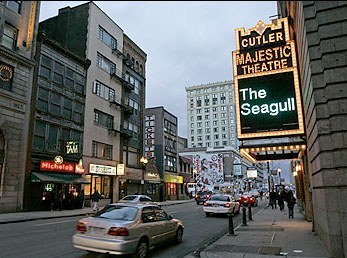There are many advantages to leasing office space in midtown Boston. The Theatre District provides a valuable reference point for many out-of-town visitors and locals alike. In addition, the presence of theaters has dictated a need for parking garages, which benefits midtown office space users. Below is a guide to the area’s many theaters:
• The Wang
• The Colonial
• The Shubert
• The Majestic
• The Wilbur
• The Charles Playhouse
• The Boston Opera House

The Wang Theatre (270 Tremont Street) – Considered the anchor of Boston’s theatre district, the Wang Theatre hosts an impressive array of world-class Broadway productions, theater, music, dance, comedy, opera and film. The Wang was first known as the Metropolitan Theatre when it opened in 1925 and was considered an important landmark of the roaring twenties. Adorned with glittering chandeliers and imposing hallways, the Met provided patrons with entertainment in the forms of motion pictures, big bands, and vaudeville.
In 1962, the theatre was renamed The Music Hall and became home to the Boston Ballet. A gift from Dr. An Wang in the mid-1980s helped restore the theatre to its previous glory.
The Colonial (106 Boylston Street) – The Colonial is Boston’s oldest operating theater, designed by the architectural firm of Clarence Blackall. During the early and mid 20th century, Boston served as a trial ground for Broadway producers to test shows before bringing them to New York. Like the Wang and the Shubert, this 1,700-seat theatre is operated by the non-profit Citi Performing Arts Center.
The Colonial is located directly in the middle of Emerson College’s campus. In fact, the recently renovated floors above the theatre are home to 372 students.
The Shubert (270 Tremont Street) – The Shubert theatre, located adjacent to the Wang, opened in 1910 and originally hosted Shakespearean productions. Like the Colonial, it played a key role as a pre-Broadway trial ground for productions such as The King and I, South Pacific, Camelot, and Mame. In 1996, the theatre underwent renovations that included a new stage, an expanded orchestra pit, improved access for disabled patrons, and updated electrical and mechanical systems.
The Cutler Majestic Theatre (219 Tremont Street) – Owned by Emerson College, “the theater employs its relationships with opera, theater, dance, and music producers and presenters, as well as its own productions and presentations, to express the vision and values of Emerson College—to explore and push the boundaries of communication, art, and culture and, thereby, to contribute to the advancement of society.” (Source)
The Majestic opened in 1903 and was hailed for its technical innovations. Designed by John Galen Howard, the theatre featured cantilevered balconies that provided unobstructed sightlines from every seat in the house, and electric lighting designed as an integral part of the building rather than in imitation of gas or candle lighting. Like other theatres in the area, it went through a series of rebirths. The Beaux-Arts opera house evolved into a movie theatre in 1955 when the Shuberts sold it to Sack Cinemas. It then fell into disrepair and was purchased by Emerson College in 1983. The College set about creating a restored theater for its own use and providing a venue for the nonprofit performing arts community. This mission was soon achieved as the theatre hosted hundreds of performances by non-profit production companies that had nowhere else to perform. A generous gift by Ted Cutler and his late wife Joan enabled an impressive restoration to take place in 2002.
The Wilbur Theatre (246 Tremont Street) – One of many Clarence Blackhall-built theatres, the Wilbur has been around since 1913. Currently the home of Boston’s Comedy Connection, this 1,200-seat theatre hosts performances by the nation’s biggest comedians.
The Charles Playhouse (74 Warrenton Street) – The Charles Playhouse was considered a pioneering theatre of the regional theatre movement. The Regional Theatre Movement, in the late 1940s and 1950s, was the work of a small number of directors, actors and producers to develop a new expression of professional theatre as an alternative to Broadway.
Boston Opera House (539 Washington Street) – Located at the northeastern corner of the Midtown submarket, the Boston Opera House hosts numerous Broadway shows, Boston Ballet performances and other high-quality cultural presentations and concerts in New England’s most magnificent theater. Constructed as memorial and tribute to vaudeville great Benjamin Franklin Keith, it opened in 1928 and was one of the most luxurious movie theatres of its time. This magnificent theatre underwent a $54 million restoration in 2004.
BRA Tip: For those interested in attending performing arts events, BosTix offers half priced tickets.